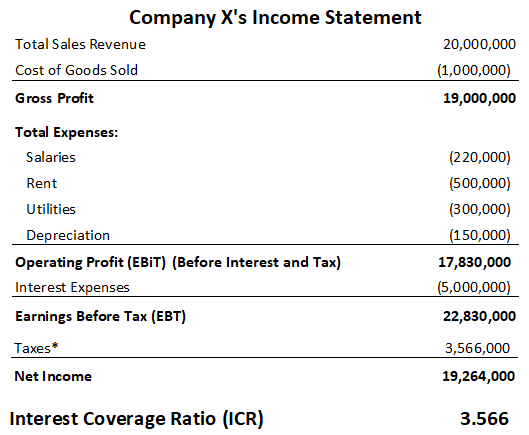The interest coverage ratio (ICR) indicates how well a company can service its long-term loans. The ICR is calculated by dividing net profit (before deducting the interest) by the total interest expenses. The ICR is expressed in times. Times interest earned or ICR is a measure of a company's ability to honor its debt payments. The ICR is also known as the debt service ratio or debt service coverage ratio. It may be calculated as either EBIT or EBITDA divided by the total interest expense of the company. The interest coverage ratio (ICR) is an important and much-studied ratio. This is especially true when borrowing is high relative to shareholder funds. This situation, known as being highly geared, is explained here. It is also particularly significant when the interest charge is high relative to profits. Obviously, a company that cannot pay its interest charge has severe problems and might not be able to carry on, at least not without a fresh injection of funds. The ICR is profit before interest and tax divided by the interest charge. The higher the ratio, the more easily the business will manage to pay the interest charge. If a company's interest coverage ratio (ICR) is high, it shows that interest payments are not a major part of the company's total expenses. The company, therefore, is likely to be able to service its interest payments comfortably. However, if the ICR is low, it means that even a small drop in the company's level of operations can make the payment of interest difficult for the company. For this reason, lenders pay close attention to the ICR. A highly geared company (i.e., a company with a high level of borrowings), will generally have a low ICR. Conversely, a low-geared company will generally have a high ratio. The formula for the interest coverage ratio (ICR) is written as follows: In this formula, the variables are: The following information was extracted from the income statement of John Trading Company: Required: Calculate John Trading Company's interest coverage ratio (ICR). Interest coverage ratio = Earnings before interest and tax / Fixed interest expenses = $300,000 / $25,000 = 12 times The earnings are 12 times greater than the interest expenses at John Trading Company. This shows that the company can comfortably cover the payments for interest expenses on its borrowings. Suppose that you receive the following data about Company X: Required: Prepare the company's income statement and calculate the interest coverage ratio (ICR). The income statement of Company X is shown below. * The company's annual income tax expense is 20%. [show_file file="webcalculators/ratios/times-interest-earned-ratio.txt"]Interest Coverage Ratio (ICR): Definition
Interest Coverage Ratio: Explanation
Interpretation of Interest Coverage Ratio
Formula to Calculate Interest Coverage Ratio

Example 1
Solution
Example 2
Solution

Interest Coverage Ratio Calculator
Interest Coverage Ratio (ICR) FAQs
The interest coverage ratio (ICR) is a measure of a company's ability to pay its debts over time. It is calculated by dividing a company's earnings before interest and taxes (EBIT) by its interest expenses. The higher the ICR, the more easily a company can pay its debt.
Factors that can affect a company's ICR include its level of debt, its earnings, and the rate of interest it pays on its debt.
There is no danger if a company has an ICR that is too high. In fact, a high ICR may be indicative of a strong company that is able to generate enough earnings to easily cover its interest expenses.
A low ICR can indicate that a company may have difficulty paying its debts over time. This may put the company at risk of defaulting on its loans or declaring bankruptcy.
There are several ways a company can improve its ICR, including reducing its level of debt, increasing its earnings, and negotiating lower interest rates on its debt.
True Tamplin is a published author, public speaker, CEO of UpDigital, and founder of Finance Strategists.
True is a Certified Educator in Personal Finance (CEPF®), author of The Handy Financial Ratios Guide, a member of the Society for Advancing Business Editing and Writing, contributes to his financial education site, Finance Strategists, and has spoken to various financial communities such as the CFA Institute, as well as university students like his Alma mater, Biola University, where he received a bachelor of science in business and data analytics.
To learn more about True, visit his personal website or view his author profiles on Amazon, Nasdaq and Forbes.











